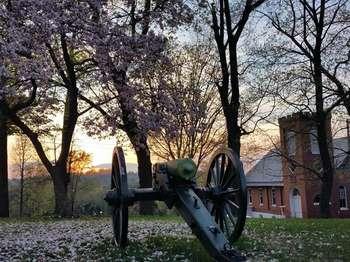Last updated: May 5, 2022
Place
Camp Hill

Historical/Interpretive Information/Exhibits, Scenic View/Photo Spot
Camp Hill is an area of the park that encompasses armory, Civil War, and civil rights stories. Visitors can drive there directly or hike to the area from Lower Town along the Appalachian Trail. If taking the hike, stop by Jefferson Rock to take in the scenery before exploring the former Storer College campus or visiting the Appalachian Trail Conservancy.
Camp Hill is a rounded knoll with steep edges that juts upward from the Potomac and Shenandoah Rivers. It hovers over the oldest section of Harpers Ferry, the Lower Town. Camp Hill's oldest feature is the Harper Cemetery, and its most famous landmark is Jefferson Rock. The land was purchased by the federal government as part of the original armory contract. Camp Hill earned its name when soldiers from the U.S. Army encamped atop the knoll during the last years of the 18th century, where they helped with the construction of the armory canal and river dam. Since the government owned the property, the streets were laid out by the government, and many of the original buildings were built, owned, and leased by the government. The most spacious lots on the crest of the hill were reserved for armory officials, which included mansions for the superintendent, the paymaster, and their assistants.
When the Civil War erupted, these mansions were abandoned, but they soon became buildings for headquarters, bivouacs, and a hospital. The Paymaster's quarters, known today as the Lockwood House, became a hospital and a prison as well. Following the Civil War, the government sold the properties to the trustees of Storer College, and these building served as the original campus. At the end of the war, Freewill Baptist missionaries from Maine utilized the Lockwood House as a school for former slaves, which became Storer College. Three of the mansions still remain the Lockwood House, the Brackett House, and the Morrell House, which still resemble their Civil War appearance.
Camp Hill served as an encampment for both Union and Confederate troops. In the spring of 1861, the Confederate army occupied the site, but abandoned the position under orders of garrison commander Joseph E. Johnston. Soon afterward, the 2nd Massachusetts Infantry arrived, which were the first Union troops of the Civil War to occupy Camp Hill. Perhaps the most famous regiment to live on Camp Hill was the 22nd New York State Militia. The 22nd New York were from New York City resided here during the summer of 1862. These men were not famous for their fighting, but for their photographs. During their stay, several hundred photos of the men and camp sites were taken upon Camp Hill, providing a glance into life in Harpers Ferry during the Civil War.
A line of earthwork fortifications ran across the western edge of Camp Hill. These works, constructed in May 1862, ran parallel to Bolivar Heights and helped defend Harpers Ferry against Stonewall Jackson's advance on May 29-30, 1862. The earthworks were improved during the summer of 1862, largely with the assistance of contraband labor, and were engaged during the Battle of Harpers Ferry in September. Once the Confederates hoisted cannons onto nearby Loudoun Heights, the Camp Hill position no longer was tenable. This convinced Union commanders to withdraw from this position during Confederate incursions in the Gettysburg Campaign of 1863 and during Jubal Early's invasion of 1864.
